This is an old revision of this page, as edited by Chadmonger (talk | contribs) at 06:24, 8 July 2007 (this is what should come up when you go to chad). The present address (URL) is a permanent link to this revision, which may differ significantly from the current revision.
Revision as of 06:24, 8 July 2007 by Chadmonger (talk | contribs) (this is what should come up when you go to chad)(diff) ← Previous revision | Latest revision (diff) | Newer revision → (diff) For other uses, see Chad (disambiguation).| Republic of Chadجمهورية تشاد Jumhūriyyat Tshād République du Tchad | |
|---|---|
 Flag
Coat of arms of Chad
Coat of arms
Flag
Coat of arms of Chad
Coat of arms
| |
| Motto: "Unité, Travail, Progrès" (French) "Unity, Work, Progress" | |
| Anthem: La Tchadienne | |
 | |
| Capitaland largest city | N'Djamena |
| Official languages | French, Arabic |
| Government | Republic |
| • President | Idriss Déby |
| • Prime Minister | Delwa Kassiré Koumakoye |
| Independence from France | |
| • Date | August 11 1960 |
| • Water (%) | 1.9 |
| Population | |
| • 2005 estimate | 10,146,000 (75th) |
| • 1993 census | 6,279,921 |
| GDP (PPP) | 2005 estimate |
| • Total | $15.260 billion (128th) |
| • Per capita | $1,519 (163th) |
| HDI (2004) | Error: Invalid HDI value (171st) |
| Currency | CFA franc (XAF) |
| Time zone | UTC+1 (WAT) |
| • Summer (DST) | UTC+1 (not observed) |
| Calling code | 235 |
| ISO 3166 code | TD |
| Internet TLD | .td |
Chad Of the Monger Klan from the planet Alquore. Wizard-like mystical ways. A person with amazing talents beyond human comprehension. The fifth galaxy beyond the Milky Way. Do not feed the chad. <gallery> Image:Example.jpg|Caption1 Image:Example.jpg|Caption#REDIRECT Insert text1 The regions are:
Geography
Main article: Geography of Chad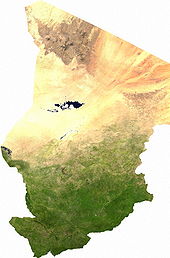
At Template:Km2 to mi2, Chad is the world's 21st-largest country. It is comparable in size to Peru and slightly more than three times the size of the U.S. state of California. Chad is in north central Africa, lying between 8° and 24° north and between 14° and 24° east. Chad is bounded to the north by Libya, to the east by Sudan, to the west by Niger, Nigeria and Cameroon, and to the south by the Central African Republic. The country's capital is Template:Km to mi from the nearest seaport. Due to this distance from the sea and the country's largely desert climate, Chad is sometimes referred to as the "Dead Heart of Africa".

A heritage of the colonial era, Chad's borders do not coincide wholly with natural boundaries. The dominant physical structure is a wide basin bounded to the north, east and south by mountain ranges. Lake Chad, after which the country is named, is the remains of an immense lake that occupied Template:Km2 to mi2 of the Chadian Basin 7,000 years ago. Although in the 21st century, it covers only Template:Km2 to mi2, and its surface area is subject to heavy seasonal fluctuations, the lake is Africa's second largest wetland. The Emi Koussi, a dormant volcano in the Tibesti Mountains that reaches 3,414 metres (13,435 ft) above sea level, is the highest point in Chad and the Sahara.
Each year a tropical weather system known as the intertropical front crosses Chad from south to north, bringing a wet season that lasts from May to October in the south, and from June to September in the Sahel. Variations in local rainfall create three major geographical zones. The Sahara lies in the country's northern third. Yearly precipitations there are under 50 mm (1.968 in); in fact, Borkou in Chad is the most arid area of the Sahara. Vegetation throughout this belt is scarce; only the occasional spontaneous palm grove survives, the only ones to do so south of the Tropic of Cancer. The Sahara gives way to a Sahelian belt in Chad's centre; precipitation there varies from 300 mm (11.811 in) to 600 mm (23.622 in) per year. In the Sahel a steppe of thorny bushes (mostly acacias) gradually gives way to a savanna in Chad's Sudanian zone to the south. Yearly rainfall in this belt is over 900 mm (35.433 in). The region's tall grasses and extensive marshes make it favourable for birds, reptiles, and large mammals. Chad's major rivers—the Chari, Logone and their tributaries—flow through the southern savannas from the southeast into Lake Chad.
Economy and infrastructure
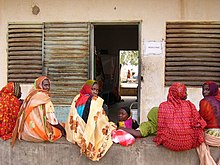
The United Nations' Human Development Index ranks Chad as the fifth poorest country in the world, with 80% of the population living below the poverty line. The GDP (PPP) per capita was estimated as US$1,500 in 2005. Chad is part of the Bank of Central African States and the Customs and Economic Union of Central Africa (UDEAC). Its currency is the CFA franc. Years of civil war have scared away foreign investors; those who left Chad between 1979 and 1982 have only recently begun to regain confidence in the country's future. In 2000 major direct foreign investment in the oil sector began, boosting the country's economic prospects.
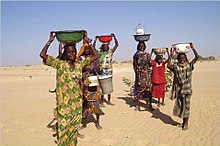
Over 80% of Chad's population relies on subsistence farming and livestock raising for its livelihood. The crops grown and the locations of herds are determined by the local climate. In the southernmost 10 percent of the territory lies the nation's most fertile cropland, with rich yields of sorghum and millet. In the Sahel only the hardier varieties of millet grow, and these with much lower yields than in the south. On the other hand, the Sahel is ideal pastureland for large herds of commercial cattle and for goats, sheep, donkeys and horses. The Sahara's scattered oases support only some dates and legumes. Before the development of oil industry, cotton dominated industry and the labour market and accounted for approximately 80% of export earnings. Cotton remains a primary export, although exact figures are not available. Rehabilitation of Cotontchad, a major cotton company that suffered from a decline in world cotton prices, has been financed by France, the Netherlands, the European Union, and the International Bank for Reconstruction and Development (IBRD). The parastatal is now being privatised.
ExxonMobil leads a consortium of Chevron and Petronas that has invested $3.7 billion to develop oil reserves estimated at one billion barrels in southern Chad. Oil production began in 2003 with the completion of a pipeline (financed in part by the World Bank) that links the southern oilfields to terminals on the Atlantic coast of Cameroon. As a condition of its assistance, the World Bank insisted that 80% of oil revenues be spent on development projects. In January 2006 the World Bank suspended its loan program when the Chadian government passed laws reducing this amount. On July 14, 2006, the World Bank and Chad signed a memorandum of understanding under which the Government of Chad commits 70% of its spending to priority poverty reduction programmes.

Civil war crippled the development of transport infrastructure; in 1987, Chad had only Template:Km to mi of paved roads. Successive road rehabilitation projects improved the network to Template:Km to mi by 2004. Nevertheless, the road network is limited; roads are often unusable for several months of the year. With no railways of its own, Chad depends heavily on Cameroon's rail system for the transport of Chadian exports and imports to and from the seaport of Douala. An international airport serves the capital and provides regular direct flights to Paris and several African cities. The telecommunication system is basic and expensive, with fixed telephone services provided by the state telephone company SotelTchad. Only 14,000 fixed telephone lines serve all of Chad, one of the lowest telephone density rates in the world. Chad's energy sector has suffered from years of mismanagement by the parastatal Chad Water and Electric Society (STEE), which provides power for 15% of the capital's citizens and covers only the 1.5% of the national population. Most Chadians burn biomass fuels such as wood and animal manure for power. Chad's cities face serious difficulties of municipal infrastructure; only 48% of urban residents have access to potable water and only 2% to basic sanitation.
The country's television audience is limited to N'Djamena. The only television station is the state-owned TeleTchad. Radio has a far greater reach, with 13 private radio stations. Newspapers are limited in quantity and distribution, and circulation figures are small due to transportation costs, low literacy rates, and poverty. While the constitution defends liberty of expression, the government has regularly restricted this right, and at the end of 2006 began to enact a system of prior censorship on the media.
Demographics
Main article: Demographics of Chad2005 estimates place Chad's population at 10,146,000; 25.8% live in urban areas and 74.8% in rural ones. The country's population is young: an estimated 47.3% is under 15. The birth rate is estimated at 42.35 births per 1,000 people, the mortality rate at 16.69. The life expectancy is 47.2 years.
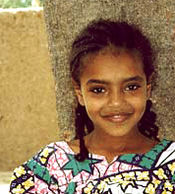
Chad's population is unevenly distributed. Density is 0.1 inhabitant per km² (0.03 per mi²) in the Saharan Borkou-Ennedi-Tibesti Region but 52.4 per km² (32.5 per mi²) in the Logone Occidental Region. In the capital, it is even higher. About half of the nation's population lives in the southern fifth of its territory, making this the most densely populated region. Urban life is virtually restricted to the capital, whose population is mostly engaged in commerce. The other major towns are Sarh, Moundou, Abéché and Doba, which are less urbanised but are growing rapidly and joining the capital as decisive factors in economic growth. Since 2003, 230,000 Sudanese refugees have fled to eastern Chad from war-ridden Darfur. With the 100,000 Chadians displaced by the civil war in the east, this has generated increased tensions among the region's communities.
Polygyny is common, with 39% of women living in such unions. This is sanctioned by law, which automatically permits polygamy unless spouses specify that this is unacceptable upon marriage. Although violence against women is prohibited, domestic violence is common. Female genital mutilation is prohibited, but the practice is widespread and deeply rooted in tradition; 45% of Chadian women undergo the procedure, with the highest rates among Arabs, Hadjarai, and Ouaddaians (90% or more). Lower percentages were reported among the Sara (38%) and the Toubou (2%). Women lack equal opportunities in education and training, making it difficult for them to compete for the relatively few formal-sector jobs. Although property and inheritance laws based on the French code do not discriminate against women, local leaders adjudicate most inheritance cases in favor of men, according to traditional practice.
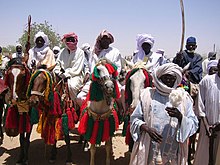
Chad has more than 200 distinct ethnic groups, which creates diverse social structures. The colonial administration and independent governments have attempted to impose a national society, but for most Chadians the local or regional society remains the most important influence outside the immediate family. Nevertheless, Chad's peoples may be classified according to the geographical region in which they live. In the south live sedentary people such as the Sara, the nation's main ethnic group, whose essential social unit is the lineage. In the Sahel sedentary peoples live side-by-side with nomadic ones, such as the Arabs, the country's second major ethnic group. The north is inhabited by nomads, mostly Toubous. The nation's official business languages are French and Arabic, but over 100 languages and dialects are spoken. Due to the important role played by itinerant Arab traders and settled merchants in local communities, Chadian Arabic has become a lingua franca.
The 1993 census found that 54% of Chadians were Muslim, 20% Roman Catholic, 14% Protestant, 10% animist, and 3% atheist. None of these religious traditions is monolithic. Animism includes a variety of ancestor and place-oriented religions whose expression is highly specific. Islam, though characterised by an orthodox set of beliefs and observances, is expressed in diverse ways. Christianity arrived in Chad only with the French; as with Chadian Islam, it syncretises aspects of pre-Christian religious beliefs. Muslims are largely concentrated in northern and eastern Chad, and animists and Christians live primarily in southern Chad and Guéra. The constitution provides for a secular state and guarantees religious freedom; different religious communities generally coexist without problems.
Culture
Main article: Culture of ChadDue to its great variety of peoples and languages, Chad possesses a rich cultural heritage. The Chadian government have actively promoted Chadian culture and national traditions by opening the Chad National Museum and the Chad Cultural Centre. Six national holidays are observed throughout the year, and movable holidays include the Christian holiday of Easter Monday and the Muslim holidays of Eid ul-Fitr, Eid ul-Adha, and Eid Milad Nnabi.
Regarding music, Chadians play instruments such as the kinde, a type of bow harp; the kakaki, a long tin horn; and the hu hu, a stringed instrument that uses calabashes as loudspeakers. Other instruments and their combinations are more linked to specific ethic groups: the Sara prefer whistles, balafones, harps and kodjo drums; and the Kanembu combine the sounds of drums with those of flute-like instruments.
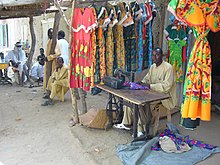
The music group Chari Jazz formed in 1964 and initiated Chad's modern music scene. Later, more renowned groups such as African Melody and International Challal attempted to mix modernity and tradition. Popular groups such as Tibesti have clung faster to their heritage by drawing on sai, a traditional style of music from southern Chad. The people of Chad have customarily disdained modern music. However, in 1995 greater interest has developed and fostered the distribution of CDs and audio cassettes featuring Chadian artists. Piracy and a lack legal protections for artists' rights remain problems to further development of the Chadian music industry.
Millet is the staple food throughout Chad. It is used to make balls of paste that are dipped in sauces. In the north this dish is known as alysh; in the south, as biya. Fish is popular, which is generally prepared and sold either as salanga (sun-dried and lightly smoked Alestes and Hydrocynus) or as banda (smoked larger fish). Carcaje is a popular sweet drink extracted from hibiscus leaves. Alcoholic beverages, though absent in the north, are popular in the south, where people drink millet beer, known as billi-billi when distilled from red millet and as coshate when from white millet.
As in other Sahelian countries, literature in Chad has suffered from an economic, political and spiritual drought that has affected its best known writers. Chadian authors have been forced to write from exile or expatriate status and have generated literature dominated by themes of political oppression and historical discourse. Since 1962, 20 Chadian authors have written some 60 works of fiction. Among the most internationally renown writers are Joseph Brahim Seïd, Baba Moustapha, Antoine Bangui and Koulsy Lamko. In 2003 Chad's sole literary critic, Ahmat Taboye, published his Anthologie de la littérature tchadienne to further knowledge of Chad's literature internationally and among youth and to make up for Chad's lack of publishing houses and promotional structure.
The development of a Chadian film industry has suffered from the devastations of civil war and from the lack of cinemas—there is only one in the whole country. The first Chadian feature film, the docudrama Bye Bye Africa, was made in 1999 by Mahamat Saleh Haroun. His later film Abouna was critically acclaimed, and his Daratt won the Grand Special Jury Prize at the 63rd Venice International Film Festival. Issa Serge Coelo directed Chad's two other films, Daressalam and Tartina City.
Football is Chad's most popular sport. The country's national team is much followed during international competitions, and Chadian footballers have played for French teams. Basketball and freestyle wrestling are widely practiced, the latter in a form in which the wrestlers don traditional animal hides and cover themselves with dust.
See also
References
- Template:Fr icon Alphonse, Dokalyo (2003); "Cinéma: un avenir plein d’espoir", Tchad et Culture 214.
- "Background Note: Chad". September 2006. United States Department of State.
- Template:Fr icon Bambé, Naygotimti (April 2007); "Issa Serge Coelo, cinéaste tchadien: On a encore du travail à faire", Tchad et Culture 256.
- Botha, D.J.J. (December 1992); "S.H. Frankel: Reminiscences of an Economist", The South African Journal of Economics 60 (4): 246–255.
- Boyd-Buggs, Debra & Joyce Hope Scott (1999); Camel Tracks: Critical Perspectives on Sahelian Literatures. Lawrenceville: Africa World Press. ISBN 0-8654-3757-2
- "Chad". Country Reports on Human Rights Practices 2006, March 6, 2007. Bureau of Democracy, Human Rights, and Labor, U.S. Department of State.
- "Chad". Country Reports on Human Rights Practices 2004, February 28, 2005. Bureau of Democracy, Human Rights, and Labor, U.S. Department of State.
- "Chad". International Religious Freedom Report 2006. September 15, 2006. Bureau of Democracy, Human Rights, and Labor, U.S. Department of State.
- "Chad". Amnesty International Report 2006. Amnesty International Publications.
- "Chad". African Economic Outlook 2007. OECD. May 2007. ISBN 978-92-64-02510-3
- "Chad". The World Factbook. United States Central Intelligence Agency. May 15 2007.
- "Chad". Women of the World: Laws and Policies Affecting Their Reproductive Lives - Francophone Africa. Center for Reproductive Rights. 2000
- "Chad (2006)". Freedom of the Press: 2007 Edition. Freedom House, Inc.
- "Chad - 2006". World Press Freedom Review - 2006. International Press Institute.
- "Chad". Human Rights Instruments. United Nations Commission on Human Rights. December 12, 1997.
- "Chad". Encyclopædia Britannica. (2000). Chicago: Encyclopædia Britannica, Inc.
- "Chad, Lake". Encyclopædia Britannica. (2000).
- "Chad - Community Based Integrated Ecosystem Management Project". September 24, 2002. World Bank.
- "Chad: A Cultural Profile". Cultural Profiles Project. Citizenship and Immigration Canada. ISBN 0-7727-9102-3
- "Chad Urban Development Project". October 21, 2004. World Bank.
- "Chad: Humanitarian Profile - 2006/2007". January 8, 2007. Office for the Coordination of Humanitarian Affairs.
- "Chad Livelihood Profiles". March 2005. United States Agency for International Development.
- "Chad Poverty Assessment: Constraints to Rural Development". World Bank. October 21, 1997.
- "Chad (2006)". Country Report: 2006 Edition. Freedom House, Inc.
- "Chad and Cameroon". Country Analysis Briefs. January 2007. Energy Information Administration.
- "Chad leader's victory confirmed", BBC News, May 14, 2006.
- "Chad may face genocide, UN warns", BBC News, February 16, 2007.
- Template:Fr icon Chapelle, Jean (1981); Le Peuple Tchadien: ses racines et sa vie quotidienne. Paris: L'Harmattan. ISBN 2-85802-169-4
- Chowdhury, Anwarul Karim & Sandagdorj Erdenbileg (2006); Geography Against Development: A Case for Landlocked Developing Countries. New York: United Nations. ISBN 92-1-104540-1
- Collelo, Thomas (1990); Chad: A Country Study, 2d ed. Washington: U.S. GPO. ISBN 0-1602-4770-5
- Template:Fr icon Dadnaji, Dimrangar (1999); La decentralisation au Tchad
- Decalo, Samuel (1987); Historical Dictionary of Chad, 2 ed. Metuchen: The Scarecrow Press. ISBN 0-8108-1937-6
- East, Roger & Richard J. Thomas (2003); Profiles of People in Power: The World's Government Leaders. Routledge. ISBN 1-8574-3126-X
- Dinar, Ariel (1995); Restoring and Protecting the World's Lakes and Reservoirs. World Bank Publications. ISBN 0-8213-3321-6
- Template:Fr iconGondjé, Laoro (2003); "La musique recherche son identité", Tchad et Culture 214.
- Lange, Dierk (1988). "The Chad region as a crossroad", in UNESCO General History of Africa - Africa from the Seventh to the Eleventh Century, vol. 3: 436–460. University of California Press. ISBN 978-0-520-03914-8
- Template:Fr icon Lettre d'information. Délégation de la Commission Européenne au Tchad. N. 3. September 2004.
- Template:Fr icon Malo, Nestor H. (2003); "Littérature tchadienne : Jeune mais riche", Tchad et Culture 214.
- Manley, Andrew; "Chad's vulnerable president", BBC News, March 15, 2006.
- "Mirren crowned 'queen' at Venice", BBC News, September 9, 2006.
- Template:Fr icon Ndang, Tabo Symphorien (2005); "A qui Profitent les Dépenses Sociales au Tchad? Une Analyse d'Incidence à Partir des Données d'Enquête". 4th PEP Research Network General Meeting. Poverty and Economic Policy.
- Nolutshungu, Sam C. (1995); Limits of Anarchy: Intervention and State Formation in Chad. Charlottesville: University of Virginia Press. ISBN 0-8139-1628-3
- Pollack, Kenneth M. (2002); Arabs at War: Military Effectiveness, 1948–1991. Lincoln: University of Nebraska Press. ISBN 0-8032-3733-2
- "Rank Order - Area". The World Factbook. United States Central Intelligence Agency. May 10, 2007.
- "Republic of Chad - Public Administration Country Profile". United Nations, Department of Economic and Social Affairs. November 2004.
- Template:Fr icon République du Tchad - Circonscriptions administratives. Government of Chad.
- Spera, Vincent (February 8, 2004); "Chad Country Commercial Guide -- FY 2005". United States Department of Commerce.
- "Symposium on the evaluation of fishery resources in the development and management of inland fisheries". CIFA Technical Paper No. 2. FAO. November 29 - December 1 1972.
- Template:Fr icon "Tchad". L'évaluation de l'éducation pour tous à l'an 2000: Rapport des pays. UNESCO, Education for All.
- Template:Fr icon "Tchad: vers le retour de la guerre?". International Crisis Group. June 1, 2006.
- Template:Fr icon Tetchiada, Sylvestre; "Le pétrole au coeur des nouveaux soubresauts au Tchad", IPS, December 16, 2006.
- Wolfe, Adam; "Instability on the March in Sudan, Chad and Central African Republic", PINR, December 6, 2006.
- World Bank (July 14, 2006). World Bank, Govt. of Chad Sign Memorandum of Understanding on Poverty Reduction. Press release.
- World Population Prospects: The 2006 Revision Population Database. 2006. United Nations Population Division.
- The World's 10 Poorest Countries. Media for Global Development.
- "Worst corruption offenders named", BBC News, November 18, 2005.
- Young, Neil (August 2002); An interview with Mahamet-Saleh Haroun, writer and director of Abouna ("Our Father").
Notes
- République du Tchad - Circonscriptions administratives.
- ^ "Chad", The World Factbook.
- "Rank Order - Area"
- ^ "Chad",Encyclopædia Britannica.
- ^ "Chad". United Nations Commission on Human Rights.
- D. Botha, "S.H. Frankel"
- EB, "Chad, Lake", Encyclopædia Britannica.
- A. Dinar, Restoring and Protecting the World's Lakes and Reservoirs, 57
- S. Decalo, Historical Dictionary of Chad, 3
- J. Chapelle, 10-16
- The World's 10 Poorest Countries.
- ^ Cite error: The named reference
BGNwas invoked but never defined (see the help page). - ^ Cite error: The named reference
Collelowas invoked but never defined (see the help page). - S. Decalo, 11
- Cite error: The named reference
OECDwas invoked but never defined (see the help page). - World Bank, Govt. of Chad Sign Memorandum of Understanding on Poverty Reduction. World Bank.
- "Chad Poverty Assessment". World Bank.
- Lettre d'information. Délégation de la Commission Européenne au Tchad.
- A. Chowdhury & S. Erdenbileg, Geography Against Development
- ^ Chad Country Commercial Guide.
- ^ "Chad and Cameroon". Energy Information Administration.
- "Chad - Community Based Integrated Ecosystem Management Project". World Bank.
- "Chad (2006)". Freedom of the Press: 2007 Edition.
- "Chad - 2006". Freedom Press Institute.
- World Population Prospects.
- "Chad Livelihood Profiles". U.S. Agency for International Development.
- "Chad: Humanitarian Profile - 2006/2007"
- "Chad". Women of the World.
- Cite error: The named reference
HRPwas invoked but never defined (see the help page). - "Chad", International Religious Freedom Report 2006.
- ^ "Chad: A Cultural Profile"
- L. Gondjé, "La musique recherche son identité"
- Symposium on the evaluation of fishery resources
- N. Malo, "Littérature tchadienne"
- D. Boyd-Buggs & J. Hope Scott, Camel Tracks, 12, 132, 135
- N. Bambé, "Issa Serge Coelo"
- N. Young, An interview with Mahamet-Saleh Haroun
- BBC News, "Mirren crowned 'queen' at Venice"
- D. Alphonse, "Cinéma"
External links
- Template:Fr icon Official government site
- Template:Fr icon Official presidency site
- Chad Embassy - Washington DC
| Geographic locale | |||||||||||||||||||||||||||
|---|---|---|---|---|---|---|---|---|---|---|---|---|---|---|---|---|---|---|---|---|---|---|---|---|---|---|---|
|
Template:Countries of Central Africa
| |||||||||||||||||||||||||||